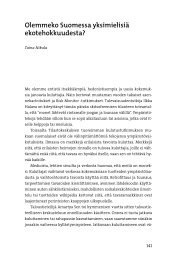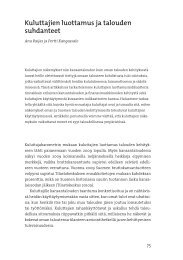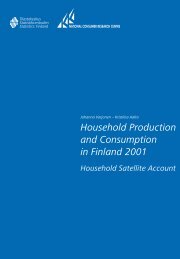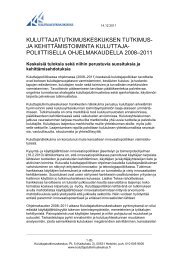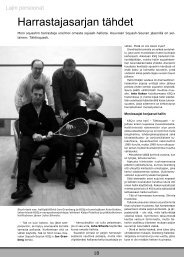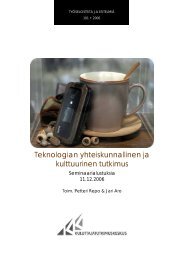Household Production and Consumption in Finland 2001
Household Production and Consumption in Finland 2001
Household Production and Consumption in Finland 2001
Create successful ePaper yourself
Turn your PDF publications into a flip-book with our unique Google optimized e-Paper software.
<strong>Consumption</strong><br />
Three types of consumption are dist<strong>in</strong>guished <strong>in</strong> the household satellite account.<br />
Firstly, there is f<strong>in</strong>al consumption, which means the actual us<strong>in</strong>g up of a product:<br />
wear<strong>in</strong>g clothes, eat<strong>in</strong>g food. Secondly, there is <strong>in</strong>termediate consumption, which<br />
refers to use of the product as part of the production process. Thirdly,<br />
consumption consists of the capital services produced by the appliances <strong>and</strong><br />
mach<strong>in</strong>es required <strong>in</strong> the production process, i.e. services offered by the means of<br />
production <strong>in</strong> question throughout their service life. Capital services consist of<br />
two items: consumption of fixed capital, i.e. depreciation of mach<strong>in</strong>ery <strong>and</strong><br />
equipment, <strong>and</strong> <strong>in</strong>terest correspond<strong>in</strong>g to the acquisition of capital. Only the<br />
consumption of fixed capital is <strong>in</strong>cluded <strong>in</strong> the Satellite Account. 3<br />
For the purposes of the Satellite Account consumption of goods <strong>and</strong><br />
services (def<strong>in</strong>ed as f<strong>in</strong>al consumption <strong>in</strong> national accounts) were divided <strong>in</strong>to<br />
three groups: 1) those that are used directly to f<strong>in</strong>al consumption; 2) those that<br />
are used as <strong>in</strong>termediate consumption goods <strong>in</strong> household production; <strong>and</strong> 3)<br />
those that are used as capital goods <strong>in</strong> household production (durable <strong>and</strong><br />
semi-durable goods). The pr<strong>in</strong>ciples of product classification are set out <strong>in</strong><br />
Appendix 2 <strong>and</strong> a detailed classification by pr<strong>in</strong>cipal functions is presented <strong>in</strong><br />
Appendix 3.<br />
Gross fixed capital formation <strong>and</strong> consumption<br />
<strong>Household</strong> capital goods were def<strong>in</strong>ed as durables <strong>and</strong> semi-durable goods that<br />
are used <strong>in</strong> household production. Calculations of capital consumption were<br />
carried out by Statistics F<strong>in</strong>l<strong>and</strong> us<strong>in</strong>g the Perpetual Inventory Method (PIM),<br />
with an assumption that consumption is l<strong>in</strong>ear. Capital goods, the proportion<br />
of these goods used <strong>in</strong> household production <strong>and</strong> their estimated service lives<br />
are shown <strong>in</strong> table 3.<br />
Estimates of service life are based on expert op<strong>in</strong>ions (e.g. Work Efficiency<br />
Institute TTS, 4 home appliance repair shops), estimates published <strong>in</strong> the<br />
Eurostat methods report (Varjonen et al. 1999) as well as figures used <strong>in</strong><br />
German <strong>and</strong> UK satellite accounts. The service life for cars is based on average<br />
scrap age accord<strong>in</strong>g to F<strong>in</strong>nish Central Organisation for Motor Trades <strong>and</strong><br />
Repairs statistics <strong>in</strong> 2002.<br />
3 In pr<strong>in</strong>ciple it might be possible to consider <strong>in</strong>clud<strong>in</strong>g <strong>in</strong>terest payable on capital so that the<br />
value of production calculated on a cost basis would correspond to the value of production<br />
based on the output method. After all, any normal market operation is expected to produce<br />
an operat<strong>in</strong>g surplus. This can be seen for <strong>in</strong>stance by compar<strong>in</strong>g the purchase of household<br />
appliances <strong>and</strong> equipment with leas<strong>in</strong>g <strong>and</strong> rental values: the sum total of all rental payments<br />
exceeds the value of the appliances because whoever is rent<strong>in</strong>g them out will want to get<br />
enough money to cover not only the value of the appliances <strong>and</strong> equipment, but also the<br />
<strong>in</strong>terest payable on capital; otherwise the operation will not make f<strong>in</strong>ancial sense. However<br />
<strong>in</strong>terest payable on capital is excluded from the analysis here, first, because for the time be<strong>in</strong>g<br />
the national accounts do not use it <strong>in</strong> the measurement of non-market production (although<br />
discussions are currently underway on the possibility of revis<strong>in</strong>g SNA recommendations <strong>in</strong> this<br />
respect) <strong>and</strong>, second, because the determ<strong>in</strong>ation of the right <strong>in</strong>terest rate is not<br />
straightforward.<br />
4 Rytkönen A, Reisbacka A (1995) Kotitalouskoneiden kestoikään vaikuttavat tekijät.<br />
Työtehoseuran julkaisuja 341.<br />
National Consumer Research Centre Statistics F<strong>in</strong>l<strong>and</strong> 21




